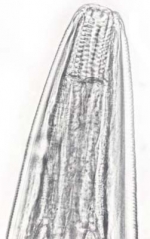NEIHPID
North-East India Helminth Parasite Information Database
Recently added
Parasites
Molecular Data
Ascarops strongylina (Alicata et McIntosh Alicata et McIntosh) Rudolphi 1819
Taxonomy
Nematoda »
SECERNENTEA »
Spirocercidae (Chitwood et Wehr, 1934) Chabaud, 1975 »
Ascaropsinae Alicata et McIntosh, 1933 »
Ascarops Beneden, 1873 »
Ascarops strongylina (Rudolphi 1819), Alicata et McIntosh 1933
Synonyms
(Spiroptera strongylina Rudolphi, 1819; Ascarops minuta Beneden, 1873)
Host
Sus (scrofa domestica)
Habitat
Stomach, Small intestine
Locality
Shillong (Meghalaya), Nongstoin (Meghalaya), Jowai (Meghalaya)
Description
Male
Body 10.0-14.0 mm in length, 0.33- 0.38 mm in maximum width. Tail coiled, with asymmetrical alae; right ala about twice as wide as left. Caudal papillae four pairs, long, pedunculate; of these three pairs pre-anal, one adanal; papillae on right side almost at same level, those on left side placed irregularly, additional pair of pedunculate papillae present in post-anal region; five pairs of post-anal small sessile papillae present on prominent raised area of cuticle with serrated margin near cloaca. Spicules unequal, dissimilar; left long, slender, finely pointed; right shorter, stout, blunt.
Female
Body 17.0-22.0 mm in length, 0.30-0.53 mm in maximum width. Tail bluntly pointed. Vulva in front of middle of body, displaced towards left side, opening just ventrally to lateral ala; constriction in region of vulva present. Vagina at first running transversely between cuticle and muscular layer of body wall, then posteriorly within body cavity. Uterine branches opposed; posterior branch doubling forward at distance of few millimeters, its ovary situated in oesophageal region; anterior branch doubling back at similar distance as posterior branch from its origin, its ovary lying in posterior region of body. Eggs oval, of irregular outline, operculate at poles, embryonated, 0.041-0.045 x 0.022-0.024 mm.
Remarks
Only two species of the genus are so far represented in the suids of the world. These, namely A. strongylina and A. dentata are distinguished from each other mainly on the basis of the body length which is up to 15 mm and 22 mm in males and females of the former species and up to 35 mm and 55 mm, respectively in males and females of the latter species. Due to the extreme coiled nature of the posterior end the caudal structures in most of the male worms could not be easily discerned.
In the description given by Baylis (1939) and Shoho and Machida (1979) there is no mention of the triangular raised area of cuticle surrounding the cloaca, as noticed in the male specimens under present investigation. The gubernaculum reported to be present by the latter authors could not be seen. However, in all other major respects the present observations are in accordance with that of Baylis (1939) and Shoho and Machida (1979).
Helminthological collections record
NEHU/Z - NM/7
References
Baylis, H. A. (1939) The Fauna of British India including Ceylon and Burma. Nematoda Vol. II (Filarioidea, Dioctophymoidea and Trichinelloidea). Originally published by Taylor and Francis, London (reprinted edition: Today
Shoho, C. and Machida, M. (1979). Nematode parasites of wild boar from Iriomote Island, Japan. Bulletin National Science Museum, Series A (Zoology). 5:pp 235-247.



.jpg)
